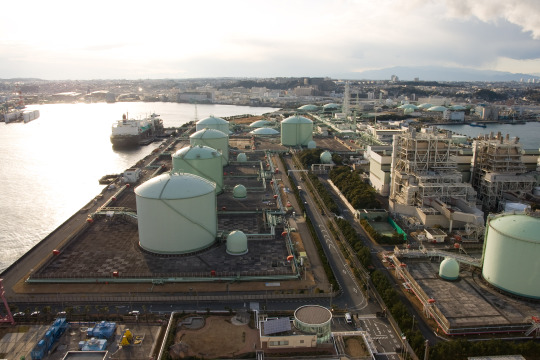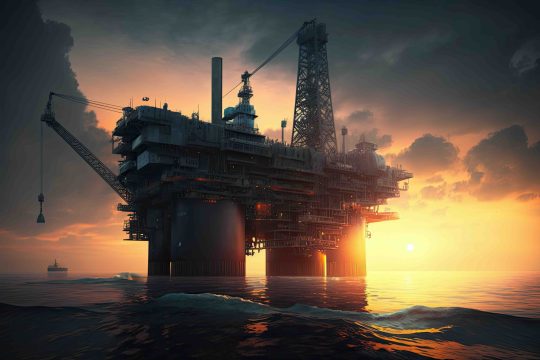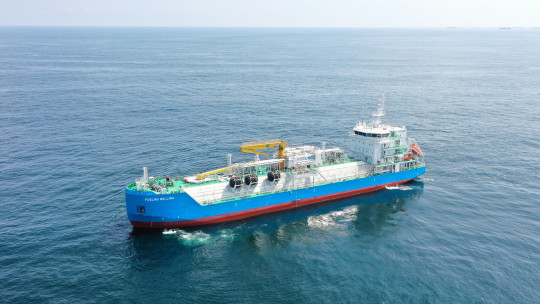#Liquefied Natural Gas (LNG)
Text
youtube
The Biden administration is pausing new projects, for environmental reasons, to increase the export of liquefied natural gas (LNG) overseas.
Natural gas by itself is the least bad fossil fuel. But gas cannot be shipped – so it needs to be liquefied. This process causes it to become more damaging to the climate.
There's also the matter of methane leaks associated with natural gas.
Donald Trump has already stated that on Day One of his dictatorship that he will "drill drill drill". Trump is an existential threat to the planet.
#liquefied natural gas#lng#methane leaks#climate change#fossil fuels#jennifer granholm#greenhouse gas emissions#the environment#ali velshi#joe biden#biden administration#donald trump#existential threat#drill drill drill#election 2024
11 notes
·
View notes
Text
By Jessica Corbett
Common Dreams
Dec. 19, 2023
Experts warn that expanding liquefied natural gas infrastructure will put the United States "on a continued path toward escalating climate chaos."
"We are scientists who write to you with ever-increasing urgency as our climate continues to deteriorate to implore you to stop the dash to increase exports of liquified natural gas (LNG)," wrote the scientists, including Rose Abramoff, Robert Howarth, Mark Jacobson, Peter Kalmus, Michael Mann, Sandra Steingraber, Farhana Sultana, and Aradhna Tripati.
While stressing their opposition to Venture Global's Calcasieu Pass 2 (CP2) project, they also emphasized that "the magnitude of the proposed buildout of LNG over the next several years is staggering."
"As scientists we are telling you in clear and unambiguous terms that approving CP2 and other LNG projects will undermine your stated goals of meaningfully addressing the climate crisis."
"For years, the science has been overwhelmingly clear that we must stop expanding fossil fuel extraction and infrastructure and rapidly transition to renewable energy. We have simply no runway left and little margin for error," the scientists warned. "In fact, we are rapidly passing tipping points that are further escalating the climate crisis."
"Altogether, the science to date shows that spiraling emissions of the climate super-pollutant methane are a major contributor to the ongoing failure to meet agreed-upon global emissions targets and stabilize the climate," they explained. "The science also shows that LNG facilities are inherently leaky operations and prodigious emitters of methane."
Their letter cites a forthcoming study by Howarth, a Cornell University scientist, that shows LNG is at least 24% worse for the climate than coal.
CP2 alone would produce over 20 times more planet-heating pollution than ConocoPhillips' Willow oil project in Alaska, which the Biden administration is also under fire for greenlighting. The letter highlights that "these climate-wrecking emissions are on top of prodigious amounts of toxic air pollutants, including carcinogenic benzene, released into local environments both from the LNG facilities themselves and the upstream drilling and fracking operations that feed them."
"LNG plants and their associated infrastructure pose serious health harms to surrounding communities and worsen environmental injustice," the scientists pointed out. "These facilities are disproportionately located in communities of color and low-income communities on the Gulf Coast already overburdened with pollution."
"You have often said that your policies will be guided by listening to the science," they wrote to Biden. "As scientists we are telling you in clear and unambiguous terms that approving CP2 and other LNG projects will undermine your stated goals of meaningfully addressing the climate crisis and put us on a continued path toward escalating climate chaos. We implore you to turn back from this course, reject CP2 and other fossil fuel export projects, and put us on a rapid and just trajectory off fossil fuels."
Opposition to CP2 may already be having some effect. Advocates had expected the Federal Energy Regulatory Commission to consider the project this fall but so far, the agency hasn't. Louisiana Bucket Brigade director Anne Rolfes said last week that "every month it is not on the agenda, we consider a victory because it means that it's not getting part of the federal approval that it needs."
While Venture Global lacks the permission required for CP2, the Biden administration has infuriated frontline communities, scientists, and voters concerned about the climate emergency by expanding LNG exports, enabling projects like Willow and the Mountain Valley Pipeline, and continuing fossil fuel lease sales for public lands and waters.
Biden, who was elected in 2020 after running on bold climate promises, is now seeking reelection next year and could again face Republican former President Donald Trump, a major ally to the fossil fuel industry.
The president "must reject new fossil fuel projects, starting with CP2, that poison communities and that will harm young people far into the future," Michele Weindling, political director of the youth-led Sunrise Movement, said Friday. "He can't one day cave to fossil fuel millionaires and the next throw a bone to young people. That's not how science works, and young voters know it."
Our work is licensed under Creative Commons (CC BY-NC-ND 3.0). Feel free to republish and share widely.
#LNG#liquefied natural gas (lng)#venture global#cp2#fossil fuels#joe biden#methane#climate crisis#climate emergency#louisiana
6 notes
·
View notes
Text
Liquefied Natural Gas (LNG) Liquefaction Equipment Market Analysis & Forecasts 2024-2032

The Reports and Insights, a leading market research company, has recently releases report titled “Liquefied Natural Gas (LNG) Liquefaction Equipment Market: Global Industry Trends, Share, Size, Growth, Opportunity and Forecast 2024-2032.” The study provides a detailed analysis of the industry, including the global Liquefied Natural Gas (LNG) Liquefaction Equipment Market share, size, trends, and growth forecasts. The report also includes competitor and regional analysis and highlights the latest advancements in the market.
Report Highlights:
How big is the Liquefied Natural Gas (LNG) Liquefaction Equipment Market?
The Liquefied Natural Gas (LNG) liquefaction equipment market size reached US$ 811.2 Million in 2023. Looking forward, Reports and Insights expects the market to reach US$ 1,226.5 Million by 2032, exhibiting a growth rate (CAGR) of 4.7% during 2024-2032.
What are Liquefied Natural Gas (LNG) Liquefaction Equipment?
Liquefied Natural Gas (LNG) liquefaction equipment is utilized to convert natural gas into its liquid state for more convenient transportation and storage. This process involves lowering the temperature of the gas to -162 degrees Celsius, causing it to condense into a clear, colorless, and non-toxic liquid. The primary components of LNG liquefaction equipment include compressors, heat exchangers, and cryogenic storage tanks. Compressors elevate the gas pressure before it enters the heat exchangers, where it is cooled using refrigerants. Once cooled, the gas is stored in cryogenic tanks until it is ready for shipment. This equipment is engineered to function efficiently under extremely low temperatures and high pressures, ensuring the safe and dependable production of LNG.
Request for a sample copy with detail analysis: https://www.reportsandinsights.com/sample-request/1765
What are the growth prospects and trends in the Liquefied Natural Gas (LNG) Liquefaction Equipment industry?
The liquefied natural gas (LNG) liquefaction equipment market growth is driven by various factors. The market for Liquefied Natural Gas (LNG) liquefaction equipment is experiencing notable expansion due to the increasing global demand for natural gas as a cleaner energy alternative. This growth is marked by the continual development of more advanced and efficient liquefaction technologies to meet the rising need for LNG. Key drivers include the ongoing expansion of LNG infrastructure, particularly in emerging markets, and the growing adoption of LNG as a fuel in various industries including transportation. Moreover, innovations in liquefaction equipment design, such as modular and space-saving units, are improving operational efficiency and reducing upfront costs. However, challenges such as high initial investments and stringent regulatory standards may pose obstacles to market growth. Hence, all these factors contribute to liquefied natural gas (LNG) liquefaction equipment market growth.
What is included in market segmentation?
The report has segmented the market into the following categories:
By Equipment Type:
Liquefaction Units
Heat Exchangers
Compressors
Storage Tanks
Pumps
Others
By Capacity:
Small-Scale (<0.5 MTPA)
Mid-Scale (0.5-2 MTPA)
Large-Scale (>2 MTPA)
By Process Cycle:
Cascade Process
Mixed Refrigerant Process
Shell-And-Tube Process
Others
By Technology:
Conventional LNG Liquefaction
Floating LNG Liquefaction
Modular LNG Liquefaction
By End-Use Industry:
Power Generation
Transportation
Industrial
Residential & Commercial
By Application:
Export/Import Terminals
Bunkering Facilities
Peak Shaving Plants
Distributed LNG Production Units
Segmentation By Region:
North America:
United States
Canada
Europe:
Germany
The U.K.
France
Spain
Italy
Russia
Poland
BENELUX
NORDIC
Rest of Europe
Asia Pacific:
China
Japan
India
South Korea
ASEAN
Australia & New Zealand
Rest of Asia Pacific
Latin America:
Brazil
Mexico
Argentina
Middle East & Africa:
Saudi Arabia
South Africa
United Arab Emirates
Israel
Who are the key players operating in the industry?
The report covers the major market players including:
Air Products and Chemicals, Inc.
Linde plc
TechnipFMC plc
Siemens Energy AG
Chart Industries, Inc.
Mitsubishi Heavy Industries, Ltd.
General Electric Company
Bechtel Corporation
McDermott International, Inc.
Baker Hughes Company
Chiyoda Corporation
Saipem S.p.A.
JGC Corporation
Samsung Engineering Co., Ltd.
KBR, Inc.
View Full Report: https://www.reportsandinsights.com/report/Liquefied Natural Gas (LNG) Liquefaction Equipment-market
If you require any specific information that is not covered currently within the scope of the report, we will provide the same as a part of the customization.
About Us:
Reports and Insights consistently mееt international benchmarks in the market research industry and maintain a kееn focus on providing only the highest quality of reports and analysis outlooks across markets, industries, domains, sectors, and verticals. We have bееn catering to varying market nееds and do not compromise on quality and research efforts in our objective to deliver only the very best to our clients globally.
Our offerings include comprehensive market intelligence in the form of research reports, production cost reports, feasibility studies, and consulting services. Our team, which includes experienced researchers and analysts from various industries, is dedicated to providing high-quality data and insights to our clientele, ranging from small and medium businesses to Fortune 1000 corporations.
Contact Us:
Reports and Insights Business Research Pvt. Ltd.
1820 Avenue M, Brooklyn, NY, 11230, United States
Contact No: +1-(347)-748-1518
Email: [email protected]
Website: https://www.reportsandinsights.com/
Follow us on LinkedIn: https://www.linkedin.com/company/report-and-insights/
Follow us on twitter: https://twitter.com/ReportsandInsi1
#Liquefied Natural Gas (LNG) Liquefaction Equipment Market share#Liquefied Natural Gas (LNG) Liquefaction Equipment Market size#Liquefied Natural Gas (LNG) Liquefaction Equipment Market trends
0 notes
Text
Qatar: A Gas Giant on the Rise
Qatar’s story is intrinsically linked to natural gas. Sitting atop the world’s largest gas field, the North Field, this small nation has transformed itself into a global energy powerhouse. But how has this surge in gas production impacted Qatar and the world stage?
For decades, Qatar has steadily increased its gas output, primarily through Liquefied Natural Gas (LNG), a super-cooled version of…

View On WordPress
0 notes
Text

Crew Members Standing Inside The Cargo Tank Of An Lng (Liquefied Natural Gas) Tanker
Severe_Brush_47
0 notes
Text
Why Joe Biden decided to “pause” natural gas exports
Why Joe Biden’s “pause” in developing new export capacity may be a bait and switch, The Dispatch reports.
Read more HERE

#world news#world politics#news#gas prices#natural gas#lng#lng exports#liquefied natural gas#fossil fuels#biden#biden administration#biden 2024#us politics#joe biden#american politics#president biden
0 notes
Text
FUCK YES!!!!!!!! Announced yesterday, Jan 26th, 2024
From the article:
New liquefied natural gas (LNG) export terminals are on hold, thanks to an early morning announcement January 26 from the White House. The Biden administration announced that it is pausing decisions on all new LNG export terminals until the US Department of Energy updates its analysis of the projects to include their climate-warming emissions and economic impacts.
...
The surprise move puts the brakes on 12 proposed LNG facilities, including Calcasieu Pass LNG, an enormous, 1000-acre project proposed for the Calcasieu Ship Channel in Cameron Parish, Louisiana. The CP2 project has been vehemently opposed by climate activists and residents of the frontline community who are already suffering the effects of several other terminals and refineries in the heavily industrialized area.
The Department of Energy has never rejected an application for an LNG export terminal. Now, the agency is being directed to consider all of the greenhouse gas emissions associated with these projects, including those created during extraction, transmission, liquefaction, and transportation overseas.
...
This announcement represents the largest single action any president has ever taken to curb fossil fuels. The new criteria will apply to all 12 proposed LNG terminals that have not yet been approved. It will not apply to those under construction or that have already received permits. The pause will likely stall decisions by the DOE from several months to over a year. Once the agency develops new guidelines, the public will have a chance to weigh in. Activists are urging supporters to keep up the pressure.
“We’re glad to know that President Biden and Energy Secretary Granholm are finally listening to us and taking action to protect Louisiana fishermen,” said Travis Dardar, an Indigenous fisherman and activist from Cameron Parish, in a press call Friday morning. But “the thing about a pause ... it can be unpaused at any time.”
...
Even as activists celebrate, they are clear about their goals: They don’t want to simply stop new proposals, but roll back the active export terminals and those under construction, which have locked us into emissions that will make it very hard to stay below the 1.5°C warming threshold that experts warn could catalyze catastrophic changes across the globe. And in an election year where some warn our very democracy is on the line, the Biden administration announcement has turned up the heat on voters.
I do recommend reading the whole article as it puts the landmark decision in context, includes quotes from both climate activists and locals (referred to as "frontline communities" in the article) who suffer from the pollution these facilities release, and talks about the potential political and climate ramifications of this decision and potential future decisions.
#personal#sierra club#liquefied natural gas#lng#lng exports#methane#climate change#climate crisis#biden
0 notes
Text
LNG tank
DSW is one of the top providers in the cryogenics tanks market, offering our customers standard and custom-made accessories and storage for cryogenics worldwide.
liquid argon tank is a storage vessel designed to hold and transport liquid argon, a colorless, odorless, non-flammable, and non-toxic gas. These tanks are typically constructed from high-quality stainless steel or aluminum, and they are insulated to maintain the low temperature required to keep argon in its liquid state. Liquid argon tanks are commonly used in various industries, including healthcare, food and beverage, welding, and scientific research. They are essential for storing and supplying liquid argon for various applications, such as cryogenic freezing, welding, and medical procedures. Safety measures and regulations should be followed when handling and using liquid argon tanks to prevent accidents and ensure proper storage and transportation.
LNG (liquefied natural gas) tank is a storage vessel designed to hold liquefied natural gas at very low temperatures. LNG tanks are typically double-walled and insulated to maintain the extremely cold temperatures required to keep the natural gas in its liquid state. These tanks are used to store and transport natural gas in its liquid form, which allows for more efficient and cost-effective transportation and storage compared to traditional gaseous natural gas. LNG tanks are commonly used in the energy industry for storing and transporting natural gas for use in power generation, heating, and industrial processes.

1 note
·
View note
Text
Peninsula Granted LNG Bunkering Operator License In Gibraltar - Peninsula

Peninsula, the leading independent global supplier of marine energy, has been granted an LNG Bunkering Operator License by the Government of Gibraltar and the Gibraltar Port Authority.
The company recently announced the arrival of its purpose-built, 12,500m3 Liquefied Natural Gas (LNG) supply vessel, Levante LNG, to the Strait of Gibraltar. The new vessel will be operated by Peninsula and will enable the company to service customers with LNG requirements in both the Gibraltar Strait and other Mediterranean ports.
John A. Bassadone, CEO of Peninsula said: “This is very welcome news. I want to thank John Ghio, Captain of the Port of Gibraltar, and The Hon Vijay Daryanani MP, for supporting our licence application and allowing us to continue our decarbonisation journey. The ability to operate our LNG vessel in the Strait of Gibraltar will bring lower-carbon solutions to vessels entering and leaving the Mediterranean. The proactivity of the Gibraltar Port Authority and the Government of Gibraltar will continue to cement the jurisdiction’s position as a leading centre for maritime excellence.”
Nacho de Miguel, Head of Alternative Fuels & Sustainability added: “This license allows us to meet lower-carbon product demand across the Western Mediterranean. The LNG-propelled vessel orderbook is looking very healthy and we want to offer solutions now to those customers taking a proactive step towards decarbonisation. As the gateway to the Mediterranean, the Port of Gibraltar will be an integral piece of the decarbonisation puzzle.”
Contact:
For all media enquiries please contact Lewis Stagnetto on +44 (0)7387 105 261 or [email protected]
LEVANTE LNG
0 notes
Text
Hello World!
Welcome to our Website! This is your first post. We will use this platform to inform our clients and vendors to take our first step in our blogging journey.
We can supply: EN 590 10PPM Euro Diesel, Russian Mazut M100, Gas Oil D2 Diesel, Russian Export Blend Crude Oil (Rebco), East Siberia-Pacific Ocean (Espo) Blend, Russian Light Cycle Oil (LCO), Aviation Kerosene Colonial Grade, Aviation…

View On WordPress
#5 & 6#Automotive Gas Oil#Aviation Kerosene Colonial Grade#Aviation Kerosene Jet Fuel#Bitumen#Dap Fertilizer#East Siberia-Pacific Ocean (Espo) Blend#EN 590 10PPM Euro Diesel#FO180cst#FO380cst#Fuel Oil Virgin (D6)#Gas Oil D2 Diesel#Gasoline Octane#Heavy Fuel Oil (HFO)#Intermediate Fuel Oil (IFO)#Liquefied Natural Gas (LNG)#Liquefied Petroleum Gas (LPG)#Marine Diesel Oil (MDO)#Petroleum Coke (Petcoke)#Residual Marine Fuel Oil (RMG)#Russian Export Blend Crude Oil (Rebco)#Russian Light Cycle Oil (LCO)#Russian Mazut M100#Ultra-Low Sulphur Diesel Euro 4#Urea#Virgin Base Oil
0 notes
Text
With less than a week left of the United Nations Climate Change Conference, more than 300 groups from over 40 countries on Friday urged the Biden administration to end the permitting of new liquefied natural gas terminals in the United States and cut off diplomatic and financial support for LNG projects abroad.
0 notes
Text
#Liquefied Natural Gas (LNG) Liquefaction Equipment Market#Liquefied Natural Gas (LNG) Liquefaction Equipment Market Size#Liquefied Natural Gas (LNG) Liquefaction Equipment Market Share#Liquefied Natural Gas (LNG) Liquefaction Equipment Market Forecast#Liquefied Natural Gas (LNG) Liquefaction Equipment Market Trends
0 notes
Text
Global LNG Bunkering Market Is Estimated To Witness High Growth Owing To Increasing Adoption of Cleaner Energy Sources

The global LNG Bunkering Market is estimated to be valued at US$592.84 million in 2021 and is expected to exhibit a CAGR of 35.26% over the forecast period of 2022-2030, as highlighted in a new report published by Coherent Market Insights.
A) Market Overview:
The LNG Bunkering Market refers to the provision of liquefied natural gas (LNG) to ships and vessels for fueling purposes. As the shipping industry strives to reduce its environmental impact, there has been a significant shift towards cleaner energy sources, with LNG being one of the preferred options. LNG offers numerous advantages such as lower emissions, cost-effectiveness, and compliance with stricter environmental regulations. It is increasingly being adopted as a fuel for various types of ships, including container vessels, tankers, and cruise ships.
B) Market Dynamics:
The LNG Bunkering Market is driven by two key factors. Firstly, the increasing adoption of LNG-fueled vehicles is propelling the demand for LNG bunkering. Shipping companies are switching from traditional fuels to LNG to comply with emission regulations and reduce air pollution. Secondly, the growing demand for cleaner energy sources is boosting the LNG bunkering market. Governments worldwide are incentivizing the use of LNG as a fuel by offering tax benefits and subsidies, further driving market growth.
For example, the International Maritime Organization (IMO) has implemented stringent regulations on sulfur emissions from ships, known as the IMO 2020 regulations. These regulations have prompted the shipping industry to adopt cleaner fuels such as LNG to meet the emission standards. Additionally, the availability of LNG infrastructure and the development of LNG bunkering hubs at various ports around the world are further fueling market growth.
C) Segment Analysis:
The LNG Bunkering Market can be segmented based on type, application, and region. Based on type, the market can be further divided into ship-to-ship, truck-to-ship, and port-to-ship bunkering. Ship-to-ship bunkering dominates the market, owing to its flexibility and efficiency in fuel supply operations. It enables ships to refuel while already at sea, reducing downtime and increasing operational efficiency.
D) PEST Analysis:
Political: Governments worldwide are implementing regulatory measures to promote the adoption of cleaner energy sources, including LNG, in the shipping industry.
Economic: The cost-effectiveness of LNG as a fuel and the availability of LNG infrastructure are driving market growth.
Social: Increasing awareness of environmental issues and the need for sustainable shipping practices are contributing to the growth of the LNG bunkering market.
Technological: Technological advancements in LNG storage and transport infrastructure, as well as the development of LNG bunkering vessels, are supporting market growth.
E) Key Takeaways:
The global LNG Bunkering Market is expected to witness high growth, exhibiting a CAGR of 35.26% over the forecast period, due to the increasing adoption of LNG-fueled vehicles and the growing demand for cleaner energy sources.
Asia-Pacific is the fastest-growing and dominating region in the LNG bunkering market, driven by countries such as China, Japan, and South Korea, which have a large shipping industry and strict emission regulations.
Key players operating in the global LNG Bunkering Market include Harvey Gulf International Marine, Petronas, Exxon Mobil Corporation, Total SE, SHV Energy, Gasum Oy, Royal Dutch Shell PLC, Broadview Energy Solutions B.V., Crowley Maritime Corporation, Polskie LNG S.A., Korea Gas Corporation, and KLAW LNG. These players are focusing on expanding their LNG bunkering infrastructure and forming partnerships to cater to the increasing demand in the market.
#LNG Bunkering Market#LNG Bunkering Market Insights#Coherent Market Insights#LNG Bunkering Market High Growth#LNG Bunkering Market Adoption#liquefied natural gas#sulfur oxide emissions#IMO#greenhouse gas emissions
0 notes
Text

What is Floating Storage & Regasification Unit?
A large container, used in the LNG industry to store, transport, and regasify liquefied natural gas is called a Floating Storage & Regasification Unit. Basically, it is a specially customized ship that is loaded with onboard facilities to store and regasification of LNG. It comprises with LNG storing tank, regasification equipment, and a pipeline connection for delivering gas for direct use.
0 notes
Text
https://brandessenceresearch.com/heavy-industry/liquefied-natural-gas-lng-market-share
0 notes